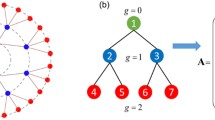Abstract
The differences in excitability along geometrically inhomogeneous, electrically excitable structures as well as the possibility of occurrence of “hot spots” at certain branch points were theoretically analysed on the basis of the Hodgkin-Huxley model assuming uniform specific membrane parameters along the structure length. It was shown that the “hot spots” conditioned by geometrical inhomogeneities should be not only morphological but also functional formations. The excitability at the branch point could be higher than that at the rest of the structure when the branch point was an electrical equivalent of a step decrease in the cable diameter. The stronger the diameter decrease, the higher the excitability at the branch point and thus the higher is the possibility of observation of “hot spots” in the nerve cells whose dendrites have a profuse branching. The realization of the “hot spots”, however, depended on the distance from the site of the stimulus application (synapse) to the branch point and on the stimulus (synaptic current) strength, as well. The closer the synaptic current strength to the threshold value, and the shorter the synapse-branch point distance, the higher was the possibility of a propagating action potential origin at the branch point but not at the site of the stimulus application and thus the higher was the possibility of realization of “hot spots”. The conclusion that the geometrical position of the initial segment contributes to its higher excitability (as compared to the rest of the cell) in the case of orthodromic activation of the neuron was also made.
Similar content being viewed by others
References
Crepel F, Dhanjal S, Garthwaite J (1981) Morphological and electrophysiological characteristics of rat cerebellar slices maintained in vitro. J Physiol 316:127–138
Dimitrov G, Dimitrova N, Pajeva I (1991) Threshold stimulation and accommodation of the Hodgkin-Huxley axon. Gen Physiol Biophys (accepted for publication)
Dimitrova N (1987) Mathematical modelling of intra- and extracellular potentials generated by active structures: effects of a step change in structure diameter. Gen Physiol Biophys 6:19–34
Dimitrova N (1988) Mathematical modelling of intra- and extracellular potentials generated by active structures with short regions of increased diameter. Gen Physiol Biophys 7:401–412
Dimitrova N, Dimitrov G (1988a) Effect of electrical stimulus parameters on the development and propagation of action potentials in short excitable fibres. Electroencephalogr Clin Neurophysiol 70:453–459
Dimitrova N, Dimitrov G (1988b) Possible mechanisms of bioelectric phenomena associated with disorders of neuromuscular transmission. In: Wallinga W, Boom H, De Vries J (eds) Electrophysiological kinesiology. Elsevier Science Publishers B V (Biomedical division), Amsterdam, pp 217–220
Dimitrova N, Dimitrov G (1991) Effect of postsynaptic current shape on fibre excitation. Gen Physiol Biophys (accepted for publication)
Ekerot C, Oscarsson O (1981) Prolonged depolarization elicited in Purkinje cell dendrites by climbing fibre impulses in the cat. J Physiol 318:207–221
Goldstein S, Rall W (1974) Changes of action potential shape and velocity for changing core conductor geometry. Biophys J 14:731–757
Hodgkin A, Huxley A (1952) A quantitative description of membrance current and its application to conduction and excitation in nerve. J Physiol 117:500–544
Joyner R, Westerfield M, Moore J, Stockbridge N (1978) A numerical method to model excitable cells. Biophys J 22:155–170
Khodorov B, Timin Y, Vilenkin S, Gulko F (1969) Theoretical analysis of the mechanisms of conduction of a nerve pulse over an inhomogeneous axon. I. Conduction through a portion with increased diameter. Biofizika (in Russian) 14:304–315
Llinas R, Nicholson C (1971) Electrophysiological properties of dendrites and somata in alligator Purkinje cells. J Neurophysiol 34:532–551
Llinas R, Sugimori M (1980) Electrophysiological properties of in vitro Purkinje cell somata in mammalian cerebellar slices. J Physiol 305:171–196
Lorente de Nó R, Condouris G (1959) Decremental conduction in peripheral nerve. Integration of stimuli in the neuron. Proc Natl Acad Sci USA 45:592–617
Moore J, Stockbridge N, Westerfield M (1983) On the site of impulse initiation in a neurone. J Physiol 336:301–311
Rall W (1962) Theory of physiological properties of dendrites. Ann NY Acad Sci 96:1071–1092
Terzuolo C, Araki T (1961) An analysis of intra- versus extracellular potential changes associated with activity of single spinal motoneurons. Ann NY Acad Sci 94:547–558
Author information
Authors and Affiliations
Rights and permissions
About this article
Cite this article
Dimitrova, N.A., Dimitrov, G.V. Difference in excitability along geometrically inhomogeneous structures and occurrence of “hot spots”. Biol. Cybern. 66, 185–189 (1991). https://doi.org/10.1007/BF00243294
Received:
Accepted:
Issue Date:
DOI: https://doi.org/10.1007/BF00243294




